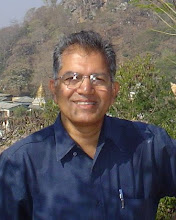The Workshop by Philip McShane "Towards a New Economic Order" began this morning at Divyadaan, Nashik.
The inaugural session involved a prayer-song in Hindi, the lighting of the lamp, and then an introduction to and welcome to the chief resource person and some of those who would interact with him: Dr Agnelo Menezes of St Xavier's College, Mumbai; Dr D.R. Bachhav, Head of the Department of Economics, KTHM College, Nashik, and myself.
I introduced Phil as well as the workshop (see my earlier blog entry for the text of my speech), after which Dr Menezes and Dr Bachhav gave their expectations of the workshop.
Dr Menezes said that he begged to disagree with the widespread idea that the Indian economy was doing well; it was not, he said; there were a very large number of people - 95% - who were not benefitting from the liberalization and the so-called surge. He summarized the problems in terms of 3 'ins': insecurity, informality (the informal or unorganized sector), and inequality.
Dr Bachhav said that the policies and plans of the government were magnificent; the problem was implementation. The agricultural sector, for example, was suffering very much.
McShane said that this was a "magnificently gloomy picture" of the Indian economy, and a wonderful start to the workshop.
He spent the next session introducing the audience to their Whats, inviting them to be Whats. The other three sessions of the day were dedicated to analysing a small business - McShane's father's bakery business. The basic circuit of demand function and supply; the need to set aside money for repair, maintenance and replacement; the recognition of a surplus circuit with its own demand function and supply. Practically the whole day was spent on this diagram, and attempting to compare it with the standard diagrams found in elementary textbooks of economics, which tended to fuse the two circuits, talking only, for example, of households and businesses and the flows of labour and money.
Dr Menezes said that he was delighted to hear this kind of analysis, and said that his college was actually making students study the local economy and analyse it carefully.
I myself asked about the traditional diagrams: what was wrong with them? What consequences followed from their failure to distinguish basic and surplus circuits?
Many of the participants - the majority of them innocent of any economics - felt that what McShane was presenting was quite agreeable, and a matter of common sense. For a layperson in the field of economics, it is probably difficult to understand why such a fundamental distinction is not drawn by most economists.
One point that became clear to me was that the four elements of the diagram did not represent concrete households or businesses, but rather demand and supply functions.
Tomorrow's sessions will complete the diagram by introducing the topics of banking and innovation, though the topic of innovation had inevitably come up during the day.
Subscribe to:
Post Comments (Atom)





No comments:
Post a Comment